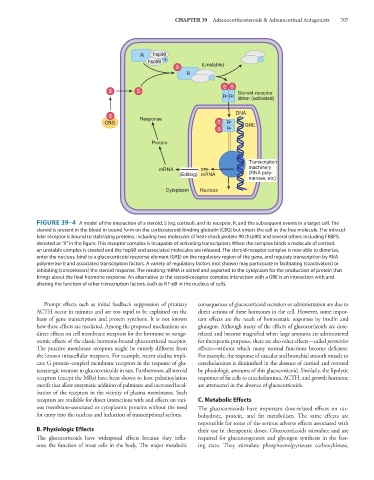Page 721 - Basic _ Clinical Pharmacology ( PDFDrive )
P. 721
CHAPTER 39 Adrenocorticosteroids & Adrenocortical Antagonists 707
R hsp90
hsp90 x
S (Unstable)
R
S S
S S Steroid-receptor
R * R * dimer (activated)
DNA
S Response
CBG S R * GRE
S R *
Protein
Transcription
mRNA pre- machinery
(Editing) mRNA (RNA poly-
merase, etc)
Cytoplasm Nucleus
FIGURE 39–4 A model of the interaction of a steroid, S (eg, cortisol), and its receptor, R, and the subsequent events in a target cell. The
steroid is present in the blood in bound form on the corticosteroid-binding globulin (CBG) but enters the cell as the free molecule. The intracel-
lular receptor is bound to stabilizing proteins, including two molecules of heat-shock protein 90 (hsp90) and several others including FKBP5,
denoted as “X” in the figure. This receptor complex is incapable of activating transcription. When the complex binds a molecule of cortisol,
an unstable complex is created and the hsp90 and associated molecules are released. The steroid-receptor complex is now able to dimerize,
enter the nucleus, bind to a glucocorticoid response element (GRE) on the regulatory region of the gene, and regulate transcription by RNA
polymerase II and associated transcription factors. A variety of regulatory factors (not shown) may participate in facilitating (coactivators) or
inhibiting (corepressors) the steroid response. The resulting mRNA is edited and exported to the cytoplasm for the production of protein that
brings about the final hormone response. An alternative to the steroid-receptor complex interaction with a GRE is an interaction with and
altering the function of other transcription factors, such as NF-κB in the nucleus of cells.
Prompt effects such as initial feedback suppression of pituitary consequences of glucocorticoid secretion or administration are due to
ACTH occur in minutes and are too rapid to be explained on the direct actions of these hormones in the cell. However, some impor-
basis of gene transcription and protein synthesis. It is not known tant effects are the result of homeostatic responses by insulin and
how these effects are mediated. Among the proposed mechanisms are glucagon. Although many of the effects of glucocorticoids are dose-
direct effects on cell membrane receptors for the hormone or nonge- related and become magnified when large amounts are administered
nomic effects of the classic hormone-bound glucocorticoid receptor. for therapeutic purposes, there are also other effects—called permissive
The putative membrane receptors might be entirely different from effects—without which many normal functions become deficient.
the known intracellular receptors. For example, recent studies impli- For example, the response of vascular and bronchial smooth muscle to
cate G protein–coupled membrane receptors in the response of glu- catecholamines is diminished in the absence of cortisol and restored
tamatergic neurons to glucocorticoids in rats. Furthermore, all steroid by physiologic amounts of this glucocorticoid. Similarly, the lipolytic
receptors (except the MRs) have been shown to have palmitoylation responses of fat cells to catecholamines, ACTH, and growth hormone
motifs that allow enzymatic addition of palmitate and increased local- are attenuated in the absence of glucocorticoids.
ization of the receptors in the vicinity of plasma membranes. Such
receptors are available for direct interactions with and effects on vari- C. Metabolic Effects
ous membrane-associated or cytoplasmic proteins without the need The glucocorticoids have important dose-related effects on car-
for entry into the nucleus and induction of transcriptional actions. bohydrate, protein, and fat metabolism. The same effects are
responsible for some of the serious adverse effects associated with
B. Physiologic Effects their use in therapeutic doses. Glucocorticoids stimulate and are
The glucocorticoids have widespread effects because they influ- required for gluconeogenesis and glycogen synthesis in the fast-
ence the function of most cells in the body. The major metabolic ing state. They stimulate phosphoenolpyruvate carboxykinase,

